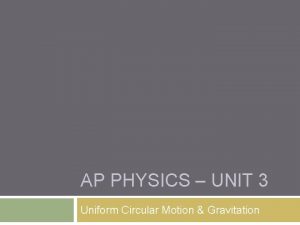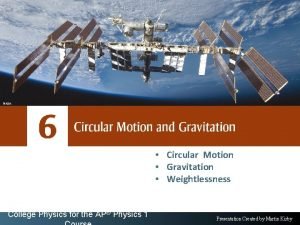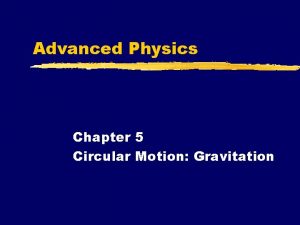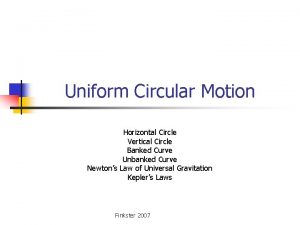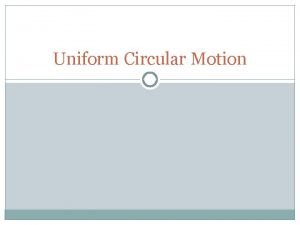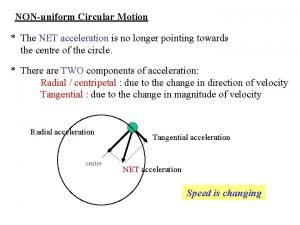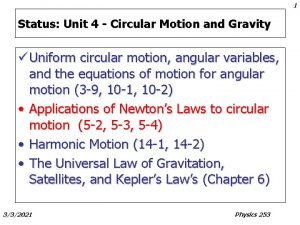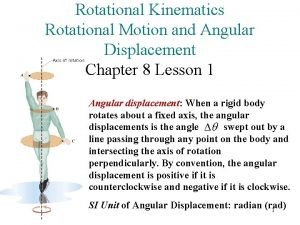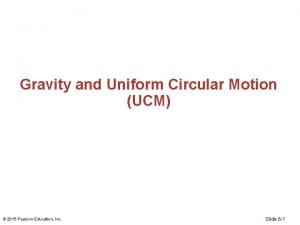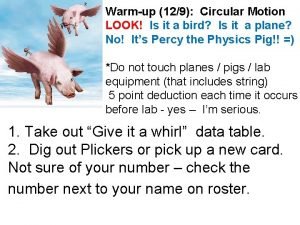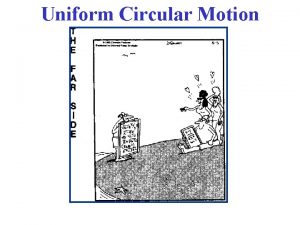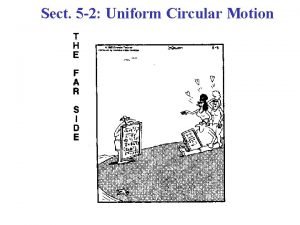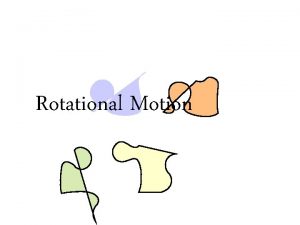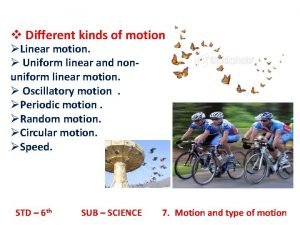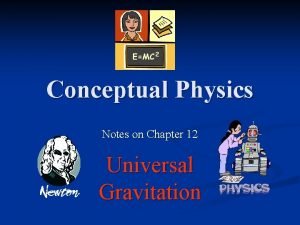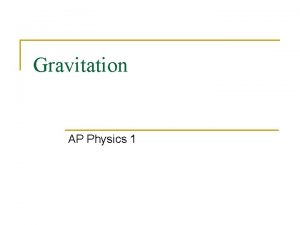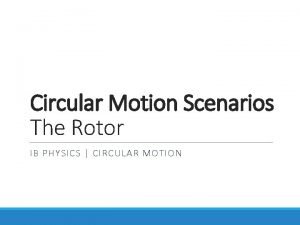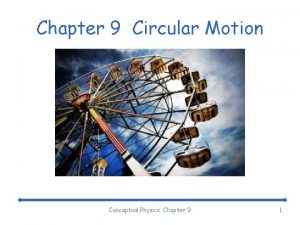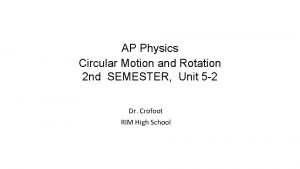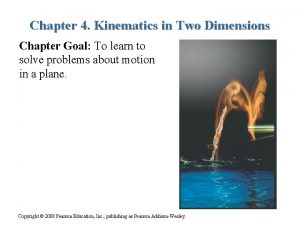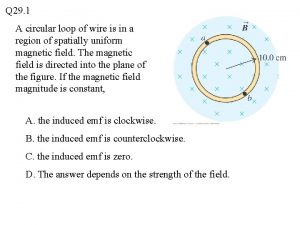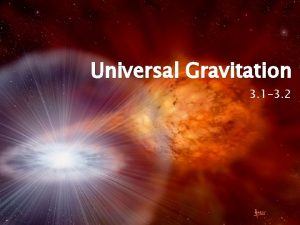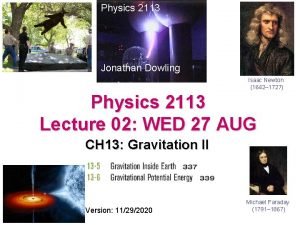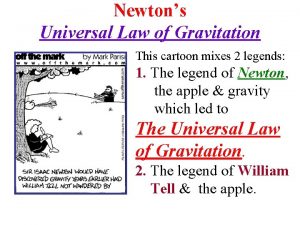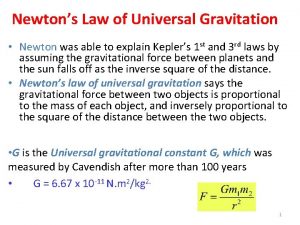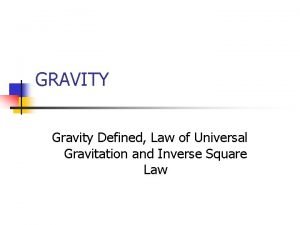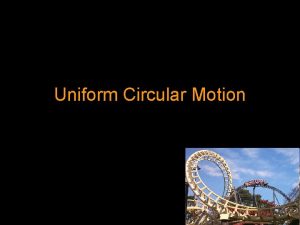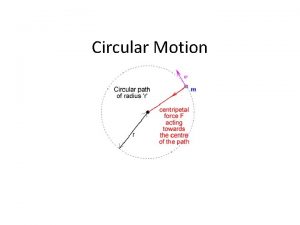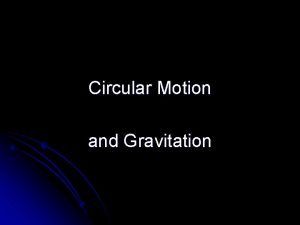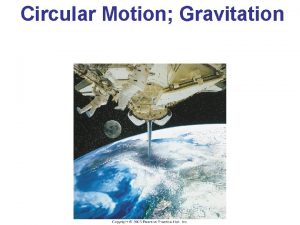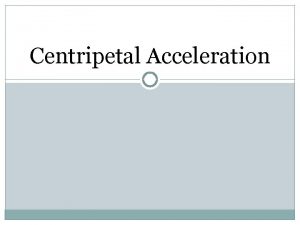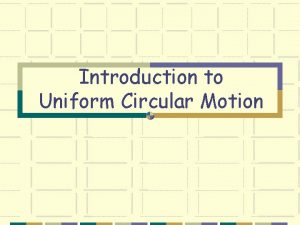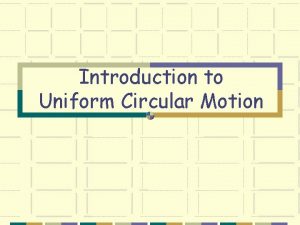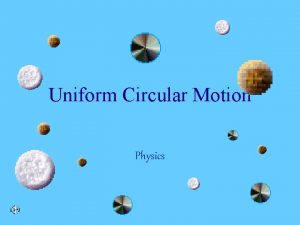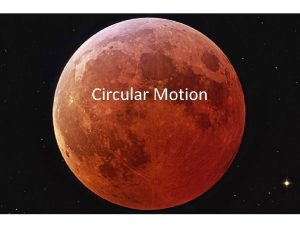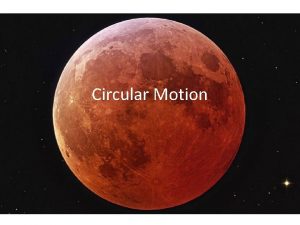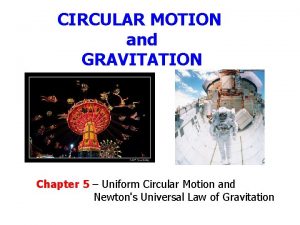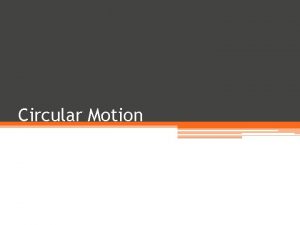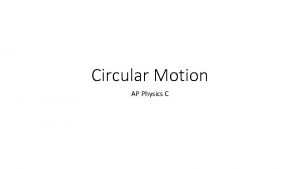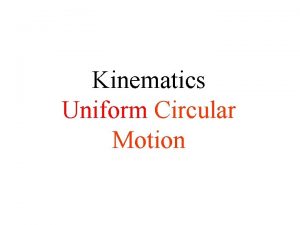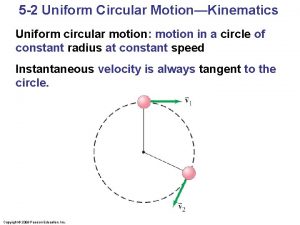AP PHYSICS UNIT 3 Uniform Circular Motion Gravitation



































- Slides: 35

AP PHYSICS – UNIT 3 Uniform Circular Motion & Gravitation

Guiding Questions 1. What force or combination of forces keeps an object in circular motion? 2. How is the motion of the moon around the Earth like the motion of a falling apple? 3. How does the effect of Earth's gravitational field on an object change as the object's distance from Earth changes?

Uniform Circular Motion

Speed/Velocity in a Circle Consider an object moving in a circle around a specific origin. The DISTANCE the object covers in ONE REVOLUTION is called the CIRCUMFERENCE. The TIME that it takes to cover this distance is called the PERIOD. Speed is the MAGNITUDE of the velocity. And while the speed may be constant, the VELOCITY is NOT. Since velocity is a vector with BOTH magnitude AND direction, we see that the direction o the velocity is ALWAYS changing. We call this velocity, TANGENTIAL velocity as its direction is draw TANGENT to the circle.

Centripetal Acceleration Suppose we had a circle with angle, q, between 2 radaii. You may recall: Dv v v q vo vo Centripetal means “center seeking” so that means that the acceleration points towards the CENTER of the circle

Drawing the Directions correctly So for an object traveling in a counter-clockwise path. The velocity would be drawn TANGENT to the circle and the acceleration would be drawn TOWARDS the CENTER. To find the MAGNITUDES of each we have:

Circular Motion and N. S. L Recall that according to Newton’s Second Law, the acceleration is directly proportional to the Force. If this is true: Since the acceleration and the force are directly related, the force must ALSO point towards the center. This is called CENTRIPETAL FORCE. NOTE: The centripetal force is a NET FORCE. It could be represented by one or more forces. So NEVER draw it in an F. B. D.

Examples

Examples

Examples The blade of a windshield wiper moves through an angle of 90 degrees in 0. 28 seconds. The tip of the blade moves on the arc of a circle that has a radius of 0. 76 m. What is the magnitude of the centripetal acceleration of the tip of the blade?

Examples Top view FN mg Side view Ff What is the minimum coefficient of static friction necessary to allow a penny to rotate along a 33 1/3 rpm record (diameter= 0. 300 m), when the penny is placed at the outer edge of the record?

Examples Venus rotates slowly about its axis, the period being 243 days. The mass of Venus is 4. 87 x 1024 kg. Determine the radius for a synchronous satellite in orbit around Venus. (assume circular orbit) Fg 1. 54 x 109 m

Examples The maximum tension that a 0. 50 m string can tolerate is 14 N. A 0. 25 -kg ball attached to this string is being whirled in a vertical circle. What is the maximum speed the ball can have (a) the top of the circle, (b)at the bottom of the circle? T mg

Examples At the bottom? T mg

Universal Gravitation

Newton’s Law of Gravitation What causes YOU to be pulled down? THE EARTH…. or more specifically…the EARTH’S MASS. Anything that has MASS has a gravitational pull towards it. What the proportionality above is saying is that for there to be a FORCE DUE TO GRAVITY on something there must be at least 2 masses involved, where one is larger than the other.

N. L. o. G. As you move AWAY from the earth, your DISTANCE increases and your FORCE DUE TO GRAVITY decrease. This is a special INVERSE relationship called an Inverse. Square. The “r” stands for SEPARATION DISTANCE and is the distance between the CENTERS OF MASS of the 2 objects. We us the symbol “r” as it symbolizes the radius. Gravitation is closely related to circular motion as you will discover later.

N. L. o. G – Putting it all together

Try this! Let’s set the 2 equations equal to each other since they BOTH represent your weight or force due to gravity SOLVE FOR g!

Example

Example

How did Newton figure this out? Newton knew that the force on a falling apple (due to Earth) is in direct proportion to the acceleration of that apple. He also knew that the force on the moon is in direct proportion to the acceleration of the moon, ALSO due to Earth Newton also surmised that SAME force was inversely proportional to the distance from the center of Earth. The problem was that he wasn’t exactly sure what the exponent was.

How did Newton figure this out? Since both the acceleration and distance were set up as proportionalities with the force, he decided to set up a ratio. Newton knew that the acceleration of the apple was 9. 8 and that the approximate distance was 4000 miles to the center of Earth. Newton also knew the distance and acceleration of the Moon as it orbits Earth centripetally. It was the outcome of this ratio that led him to the exponent of “ 2”. Therefore creating an inverse square relationship.

Example What is the gravitational force between the earth and a 100 kg man standing on the earth's surface? 9. 81 x 102 N Because the force near the surface of Earth is constant, we can define this force easier by realizing that this force of gravitation is in direct proportional to the man’s mass. A constant of proportionality must drive this relationship. We see that this constant is in fact the gravitational acceleration located near the Earth’s surface.

Example How far from the earth's surface must an astronaut in space be if she is to feel a gravitational acceleration that is half what she would feel on the earth's surface? 2. 64 x 106 m This value is four tenths the radius of Earth.

A couple of things to consider about Earth You can treat the earth as a point mass with its mass being at the center if an object is on its surface The earth is actually not uniform The earth is not a sphere The earth is rotating Let's assume the earth is a uniform sphere. What would happen to a mass (man) that is dropped down a hole that goes completely through the earth? Digging a hole at the Forbidden City in Beijing will cause you to end up somewhere in Argentina. But don’t be surprised if you dig somewhere else and water starts to pour in!

Digging a hole When you jump down and are at a radius “r” from the center, the portion of Earth that lies OUTSIDE a sphere a radius “r” does NOT produce a NET gravitational force on you! The portion that lies INSIDE the sphere does. This implies that as you fall the “sphere” changes in volume, mass, and density ( due to different types of rocks) r This tells us that your “weight” actually DECREASES as you approach the center of Earth from within the INSIDE of the sphere and that it behaves like Hook’s Law. YOU WILL OSCILLATE.

Kepler’s Laws

Kepler's Laws There are three laws that Johannes Kepler formulated when he was studying the heavens THE LAW OF ORBITS - "All planets move in elliptical orbits, with the Sun at one focus. ” THE LAW OF AREAS - "A line that connects a planet to the sun sweeps out equal areas in the plane of the planet's orbit in equal times, that is, the rate d. A/dt at which it sweeps out area A is constant. ” THE LAW OF PERIODS - "The square of the period of any planet is proportional to the cube of the semi major axis of its orbit. "

Kepler’s 1 st law – The Law of Orbits "All planets move in elliptical orbits, with the Sun at one focus. ”

Kepler’s 2 nd Law – The Law of Areas "A line that connects a planet to the sun sweeps out equal areas in the plane of the planet's orbit in equal times, that is, the rate d. A/dt at which it sweeps out area A is constant. ”

Kepler’s 2 nd Law How do we know that the rate at which the area is swept is constant? Angular momentum is conserved and thus constant! We see that both are proportional to the same two variables, thus Kepler's second law holds true to form.

Kepler’s 3 rd Law – The Law of Periods "The square of the period of any planet is proportional to the cube of the semi major axis of its orbit. " Gravitational forces are centripetal, thus we can set them equal to each other! Since we are moving in a circle we can substitute the appropriate velocity formula! The expression in the RED circle derived by setting the centripetal force equal to the gravitational force is called ORBITAL SPEED. Using algebra, you can see that everything in the parenthesis is CONSTANT. Thus the proportionality holds true!

Examples

Examples
 Unit 3 circular motion and gravitation
Unit 3 circular motion and gravitation Circular motion
Circular motion Chapter 5 circular motion gravitation
Chapter 5 circular motion gravitation Vertical r
Vertical r Uniform circular motion lab
Uniform circular motion lab Non uniform circular motion
Non uniform circular motion Rtz coordinate system
Rtz coordinate system Non uniform circular motion
Non uniform circular motion Dynamics of uniform circular motion
Dynamics of uniform circular motion Motion map examples
Motion map examples Angular velocity units
Angular velocity units Normal force in uniform circular motion
Normal force in uniform circular motion Centripetal velocity formula
Centripetal velocity formula What is uniform circular motion
What is uniform circular motion Circular motion with constant speed
Circular motion with constant speed Time formula in circular motion
Time formula in circular motion Linear motion images
Linear motion images Conceptual physics chapter 13 universal gravitation
Conceptual physics chapter 13 universal gravitation Newton's universal law of gravitation ap physics 1
Newton's universal law of gravitation ap physics 1 Rotor ride physics free body diagram
Rotor ride physics free body diagram Circular motion conceptual physics
Circular motion conceptual physics Ap physics circular motion
Ap physics circular motion Si unit of circular motion
Si unit of circular motion Which type of lines are used to soften a design?
Which type of lines are used to soften a design? A circular loop of wire
A circular loop of wire How do you classify uniform and non-uniform mixtures?
How do you classify uniform and non-uniform mixtures? Grade 7 science unit 3 mixtures and solutions answers
Grade 7 science unit 3 mixtures and solutions answers Rumus kecepatan
Rumus kecepatan Explain newton’s universal law of attraction/gravitation.
Explain newton’s universal law of attraction/gravitation. Gauss theorem
Gauss theorem Gravitational constant
Gravitational constant Acceleration due to gravity
Acceleration due to gravity Newton's law of gravitation
Newton's law of gravitation Formula for total mechanical energy
Formula for total mechanical energy Universal gravitation law
Universal gravitation law Angular velocity to tangential velocity
Angular velocity to tangential velocity
